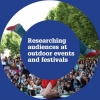Guide and Toolkit for Audience Research at Festivals and Outdoor Events
Publicat per Interacció el 15/01/2013 - 16:11 | Última modificació: 11/12/2015 - 14:57
Measuring and evidencing the impact of an outdoor event can be harder than with other artforms, because of often widespread locations and the fact that many such events are unticketed.
We have produced a new set of guidelines with an associated toolkit for audience research at outdoor events.
The guidelines cover the following sections:
- Introduction and context: good reserach principles, the challenges we face and how to use the guidelines.
- Evidencing success: the types of evidence yo umay need to collect, how to match these to your objectives and how to report evidence successfully.
- Data collection methods: pros and cons of various methods, taking into account factors such as cost, staff resources, time commitments, access issues and the accuracy and quality of data.
- Using questionnaires: a guide to key question areas, advice on design and a sample questionnaire for you to adapt.
- Sampling for surveys: advice on sample sizes, random sampling and maximising response rates.
- Estimating audience size: the importance of accurate estimates in planning and evaluating and the pros and cons of various methods.
- Working with volunteers: Best practice guide for recruiting, training and rewarding a team of volunteers.
- Assessing economic impact: how economic impact is calculated
- Research guidelines and data protection: the key legislation you need to be aware of when collecting personal data and the main principles of the Market Research Society code of conduct.
Grups de treball:
Centre d'Informació i Documentació - blog de Interacció
- 3192 lectures





